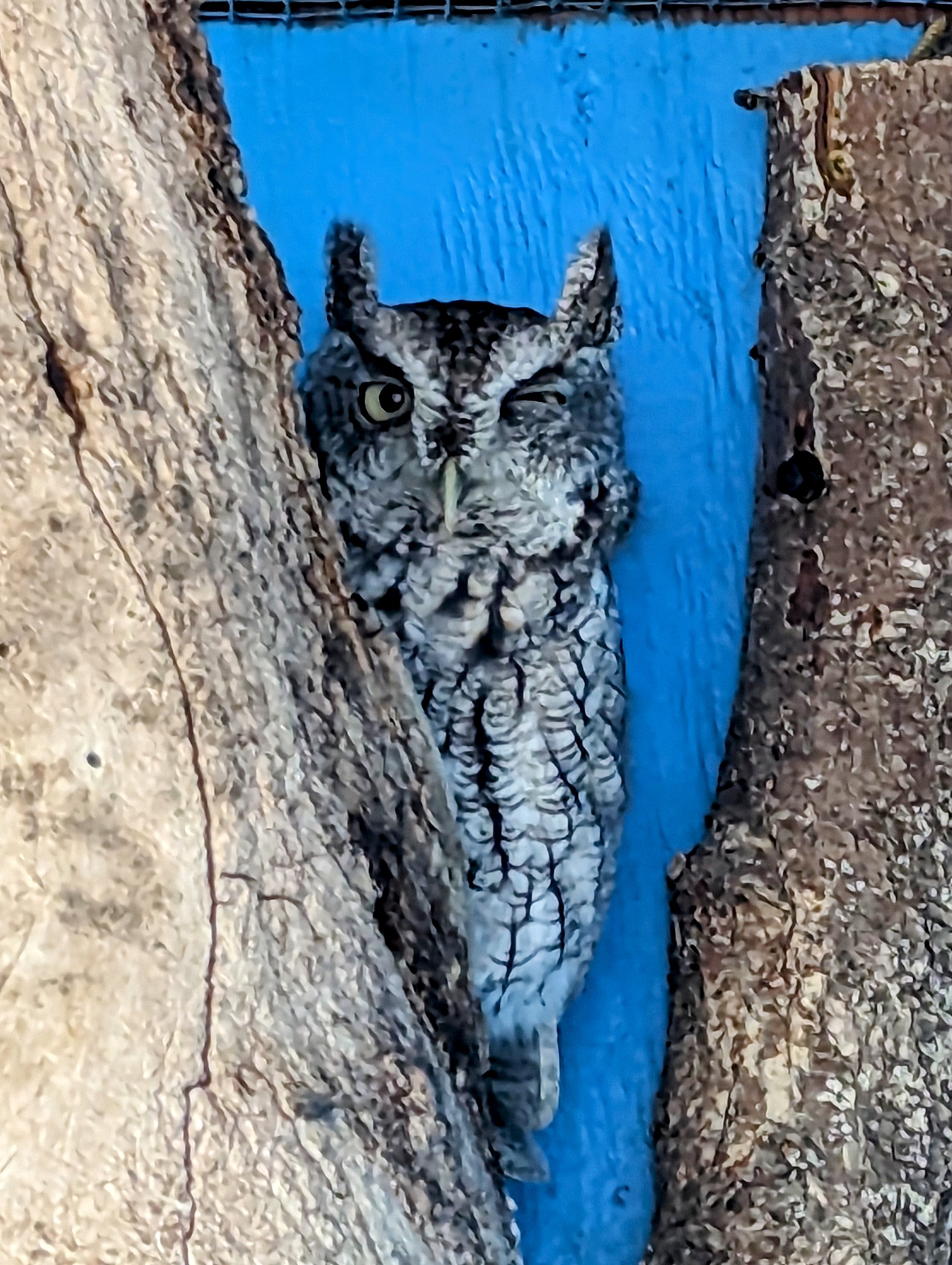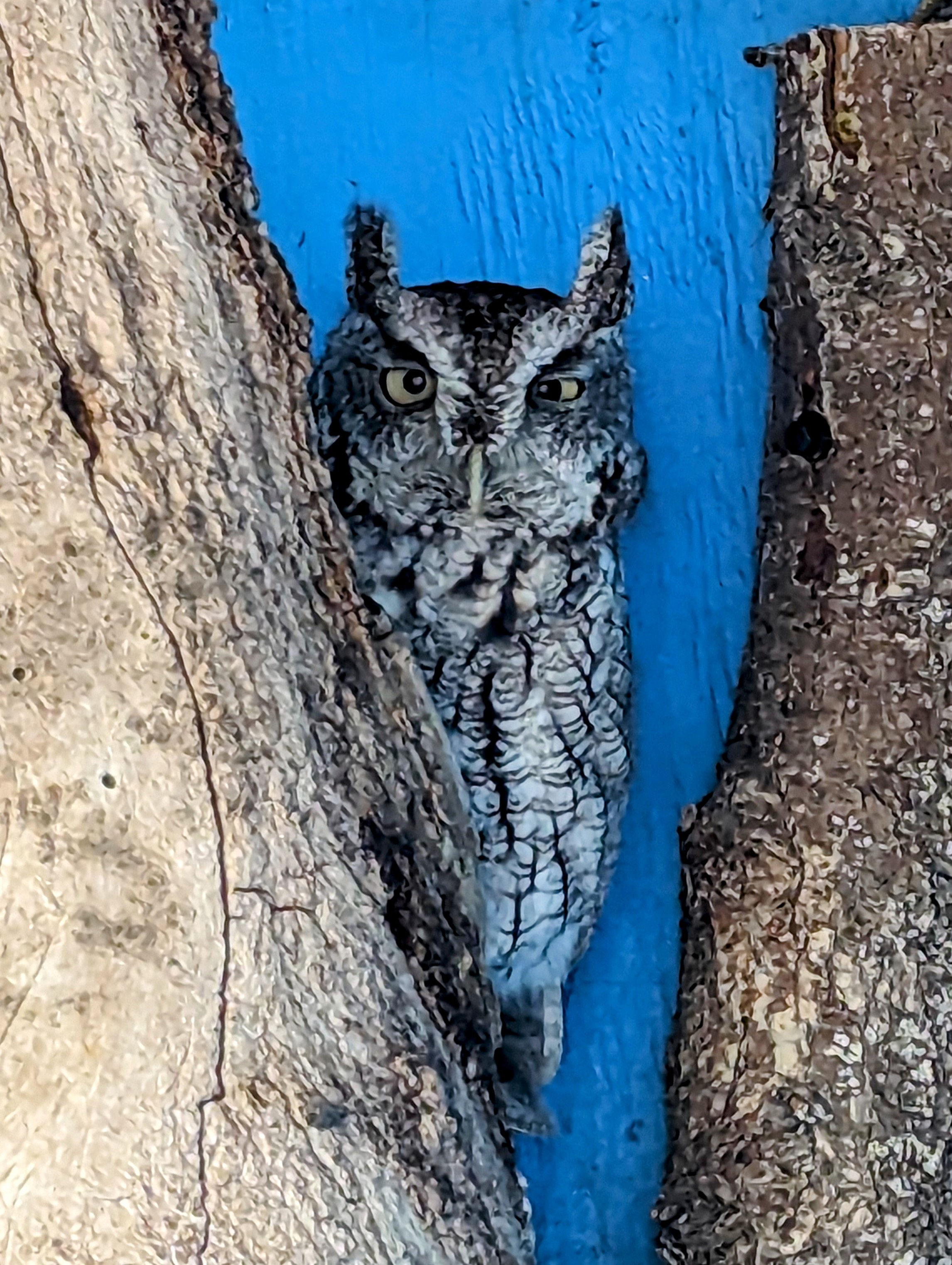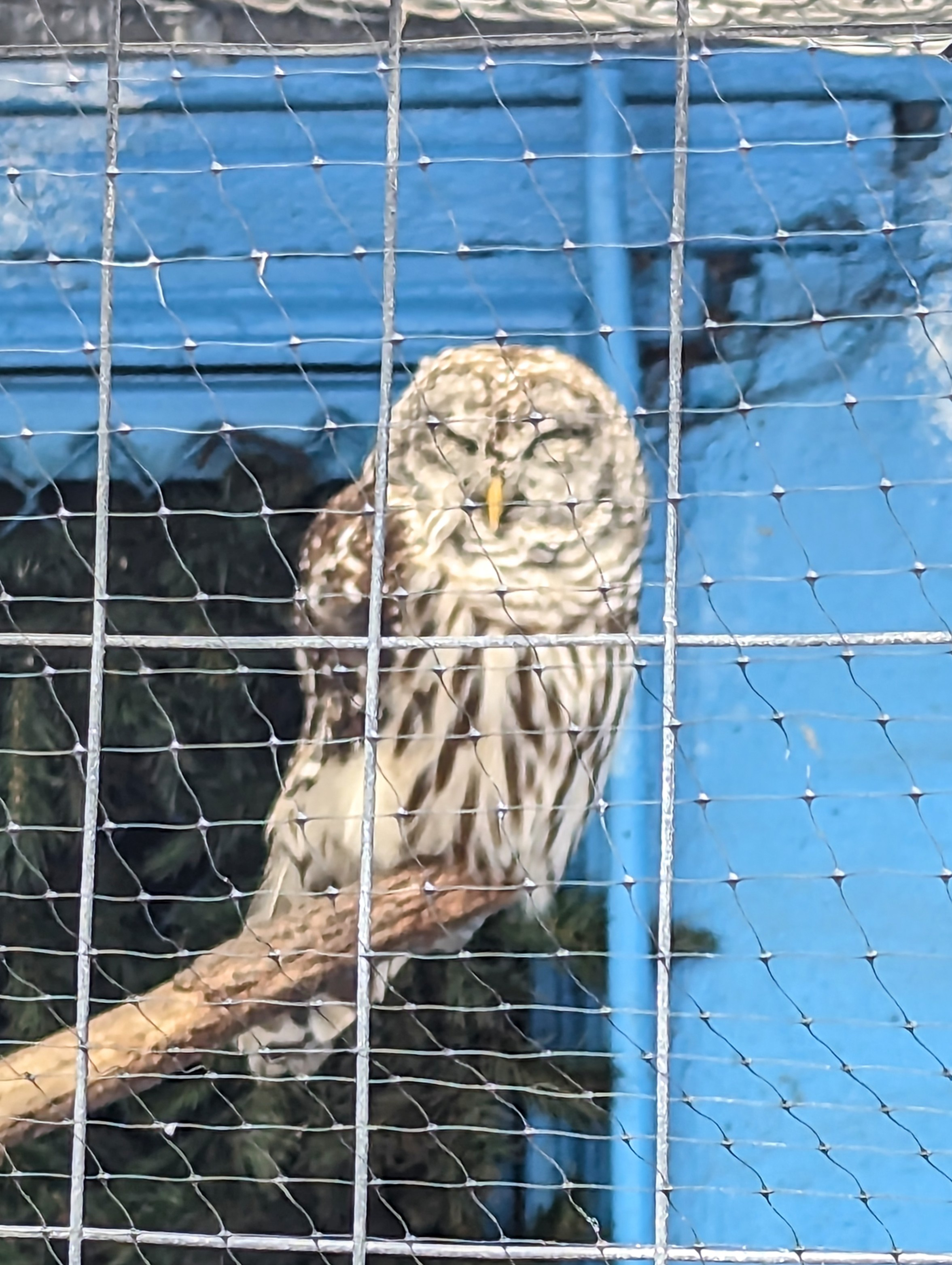I know these aren’t the best photos, I’m no photographer, I’m just using my phone, and they didn’t bring any of the animals out, so they’re all being either 2 or 4 layers of protection. I hope you still enjoy them.
The lead photo here is a cute little Eastern Screech Owl. His name is Otis. In the 3 times I’ve visited him now, he’s always been a pretty shy guy.
I got to talk to one of his staff when she came to feed the birds and she said she’s never actually seen him eat, and when I came back for the night tour, his food was still out, so he seems to wait until everyone is gone for the day.
I asked what they got to eat, and she said the screechie gets a mouse and a chick per day, and the GHO got a rat.
Here’s some more pics of Otis.





This is the only other pic of Annabelle that was with sharing. She’s behind 2 layers of chicken wire and also 2 layers of nylon bird netting, which I imagine is there for the sake of both the songbirds and children that visit the park. GHO are apex predators and will often decapitate their prey after breaking the spine, so not the best show for a young audience.
One new fact I got to learn on the tour was GHO are big enough and have enough fluff that they can successfully hunt porcupines. They also mentioned skunks will avoid going out in the darkest parts of the night even though they are nocturnal. Skunks are unusually brave for their size since most animals won’t mess with them, but since owls have poor to no sense of smell, that makes them functionally immune to the skunk’s spray, and over the centuries skunks have learned this and will avoid being blindsided by the owl when possible.
This was her licking her beak post-pellet, so that’s why she’s got a peculiar expression.

This Barred Owl is named Hootie, and in my trips here it always seems he’s in the same spot with his eyes closed. I learned yesterday that is because Hootie is old AF for an owl.
Hootie came there about 20 years ago already as an adult. He has had a wing amputation, which was banned over 20 years ago. At this point in his life, he has lost one eye due to unsuccessful surgery to repair it, and the other has floating cataracts, hence always looking like his eyes are closed. This is one tough bird!

Here are the 2 resident vultures, plus a few wild ones hanging out. The first with the red face is a Turkey Vulture, the second is a Black Vulture, and all the ones on the fencing are black also. If you zoom in, you can see some are tagged.
There were many vultures circling and hanging around the park. The guide says they’re “missing” right now, but vulture migration is a little simpler than for other birds. They only go as fast south as it takes to find their next few meals, not to any specific destination.
He also says vultures circling is rarely a sign they’re above something dead or dying. He says vultures don’t enjoy sharing meals. He says they can all smell blood up to 5 miles away, rivaling sharks for best sense of smell of any animal, so they ask just tend to congregate because they take notice to the same things. Them chectking is just them riding warm air currents to save energy. Notice them circling and you will see they don’t have to flap their wings much, so it’s mainly just them conserving energy.



They have 2 wolves, Hunter and Scout. We learned many interesting things about them. They are old at this point for wolves, 15, and they live as long as your average canine, so if you’re near the north of Philadelphia area and want to see some white wolves, don’t wait too long is all I’ll say on that!


I had a good opportunity to see Margough the bobcat. We learned she was a pet until the owner had to move to a state that rightfully didn’t let people keep wild cats as pets. Even though she was raised by humans, they said she does not really enjoy people, and even though the go in the wolf pen, they will absolutely not go in with the bobcat.
They said she can leap 10 feet (just over 3 meters) in the air, and snatches about 3 birds a day that make the mistake of entering her area, and she had grabbed a number of squirrels through the screening over the years. She’s one cat lady you don’t want to mess with.

They had a lot more animals that I couldn’t get good pictures of. We learned many new things about their turkeys, foxes, skunks, raccoons, porcupine, and other more farm type animals. It was a great visit and in really glad I stayed for the night tour. The guides were super knowledgeable about the park itself and the animals.
I talked to the one guide about laws and permitting since I come up with a lot of questions about it looking for places you guys can go visit animals. There are tons of rules spread across numerous agencies about what you can and can’t do, and it seems, at least here in Pennsylvania, there are many rules against using wild or previously injured animals for display purposes. I imagine this is the case for most places, as it keeps a financial incentive away from trapping or stealing wild animals for profit. All that beaurocracy is what makes it hard to find these smaller places for you to see these animals more personally than at a zoo. Word of mouth send the best way to find these places, which is how I originally learned of this park and the other one nearby that I go to the open house they have twice a year.
The other thing we talked about was something I mentioned in the big feather post Friday about how it is illegal to own feathers or parts of dead birds without a difficult to get permit.
They had a bald eagle I was lucky enough to see in my previous visits, but had since died of natural causes. He currently has it in a freezer, because he is required to send it to Washington DC for legal disposal. The limited resources for such things though has the process back up by months though, so he is still stuck holding on to this bird.
When he finally does get authorization to ship it, it will be DNA sequenced, and feathers will be sent to Native People who have applied for eagle feathers. That is how serious they take the law surrounding these feathers. It sounds funny that having a feather can be a federal crime, but it seriously is! Those feathers are more controlled and regulated than most drugs or guns. It suppose that says something about American priorities, but we’ll leave that for other communities to talk about. But it does heavily discourage people hunting eagles and other rare birds, so I suppose it’s for the best.
Somewhat even more amazing though, was he also has a frozen eagle he has been required to hold into for 12 years now! What has made that situation more complicated is that bald eagle died due to West Nile Virus, making it illegal to transport! So it is a felony for him to destroy it, and the government has not given them instructions for them to collect it, so it’s stuck indefinitely in cold storage. I thought that was simply astounding, but it makes sense in the framework of the existing laws.
Ok, this was a way longer post than I was planning to make, but I learned so much neat stuff last night on the free tour. I shared with you probably not even half what I learned. I hope you enjoyed the not so great pictures, but also all the things I learned. I know the regulation stuff was very interesting to me, but probably not everyone’s favorite thing.


Thank you for this amazing post! I learned a lot and also liked the pictures. If you have more to share, be it pictures or what you learned, I‘d love to hear!
Some other quick facts I can remember:
Turkeys sleep in trees. I knew this, but had forgotten it because I’m not out in the woods after dark much.
Skunks come in both 1 and 2 striped versions.
Foxes carry a toooooon of fatal diseases which WILL ALL EASILY PASS TO YOUR DOG! Do not let your dog near foxes and do not leave meat or dog/cat food outside if you have pets because you will get foxes.
A positive fox fact is they can roam up to 30 square miles (78 sq km) and keep several dens that they rotate through every week or 2 to fool predators.
Raccoons are another animal you shouldn’t encourage to hang out at your house. Besides they’re curiosity and agility making them very accidentally destructive to your stuff, theyn hold the world record for spreading rabies. Most animals will succumb to the disease in a week or 2. Raccoons will survive and be contagious for 1-2 YEARS!
Mouth frothyness is also one if the worst signs to look for to indicate rabies. It’s a very rare symptom, and usually does not show up until very soon before death. Raccoons especially are lacking in salivary glands to begin with, making the foamy mouth even less common. They don’t “wash” their food, so much as they are softening it to aid swallowing, like if you’ve seen people in a hot dog eating contest dip the buns in water.
The best way to tell if a wild animal has rabies, distemper, etc is that it is acting abnormally. He says the foxes will look to the sky and seem like they’re talking to themselves. But the best way to tell something is not right with a wild animal is if it lets you or your pet anywhere near it! Wild animals don’t want to be anywhere near us or our pets. We are a natural threat to them for many reasons, and if they let us approach, something is likely very wrong with them!
The alpha wolf eats first and then pees on the rest of the food when he’s done to keep the other pack member’s in their place.
Wolf howls also supposedly do not create an echo. This allows them to communicate, but not to alert all their potential prey of their exact locations.
Grey foxes can climb trees like a cat due to their flexible wrists. They sometimes will live many feet up in hollowed out trees.
Red foxes can be grey. They had a red and a grey Red Fox there. They way to tell if it’s a red fox is if the tail looks like it was dipped in white paint, it’s a red fox.
There were a few new owl facts, but I’m going to save them for later.
This wasn’t even all we learned in the hour tour. I was so glad I stayed for it. I thought I knew more about some of these animals than I did.